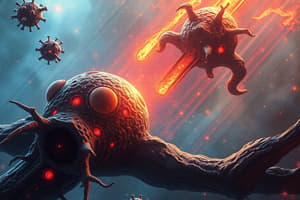Podcast
Questions and Answers
Which type of leukocyte is initially recruited in response to bacterial infections?
Which type of leukocyte is initially recruited in response to bacterial infections?
- Monocytes
- Neutrophils (correct)
- Eosinophils
- Lymphocytes
What type of leukocyte is predominantly recruited during the first 6 to 24 hours in response to necrosis?
What type of leukocyte is predominantly recruited during the first 6 to 24 hours in response to necrosis?
- Neutrophils (correct)
- Eosinophils
- Lymphocytes
- Monocytes
Which leukocyte type is recruited in viral infections?
Which leukocyte type is recruited in viral infections?
- Neutrophils
- Monocytes
- Eosinophils
- Lymphocytes (correct)
What is the predominant leukocyte recruited after 24 to 48 hours in response to necrosis?
What is the predominant leukocyte recruited after 24 to 48 hours in response to necrosis?
Which type of reaction induces a mixed infiltrate of leukocytes?
Which type of reaction induces a mixed infiltrate of leukocytes?
What is the primary driving force for leukocyte movement after traversing the endothelium?
What is the primary driving force for leukocyte movement after traversing the endothelium?
What triggers the polymerization of actin at the leading edge of the cell and facilitates cell movement in the direction of the locally produced chemoattractant?
What triggers the polymerization of actin at the leading edge of the cell and facilitates cell movement in the direction of the locally produced chemoattractant?
Which molecule is responsible for mediating the firm adhesion between leukocytes and endothelium?
Which molecule is responsible for mediating the firm adhesion between leukocytes and endothelium?
What is the site at which there is maximal retraction of endothelial cells during extravasation of leukocytes?
What is the site at which there is maximal retraction of endothelial cells during extravasation of leukocytes?
What is the primary mechanism by which leukocytes move after extending pseudopods?
What is the primary mechanism by which leukocytes move after extending pseudopods?
What is the predominant leukocyte recruited after 24 to 48 hours in response to necrosis?
What is the predominant leukocyte recruited after 24 to 48 hours in response to necrosis?
Which type of leukocyte is initially recruited in response to bacterial infections?
Which type of leukocyte is initially recruited in response to bacterial infections?
Which leukocyte type is recruited in viral infections?
Which leukocyte type is recruited in viral infections?
What type of leukocyte is predominantly recruited during the first 6 to 24 hours in response to necrosis?
What type of leukocyte is predominantly recruited during the first 6 to 24 hours in response to necrosis?
Which molecule is responsible for mediating the firm adhesion between leukocytes and endothelium?
Which molecule is responsible for mediating the firm adhesion between leukocytes and endothelium?
What is the process defined as locomotion along a chemical gradient?
What is the process defined as locomotion along a chemical gradient?
What are the two major adhesion molecule pairs involved in leukocyte rolling and adhesion to endothelium?
What are the two major adhesion molecule pairs involved in leukocyte rolling and adhesion to endothelium?
What stimulates leukocytes to travel along a chemical gradient in extravascular tissues?
What stimulates leukocytes to travel along a chemical gradient in extravascular tissues?
Which leukocyte type undergoes apoptosis after 24 to 48 hours?
Which leukocyte type undergoes apoptosis after 24 to 48 hours?
What is the primary mechanism by which leukocytes migrate through the vessel wall?
What is the primary mechanism by which leukocytes migrate through the vessel wall?




